Dispatch 6
Date: June 17, 2001. Sunday. Father’s Day.
Location: Beijing, then Nanchang.
Before we left Beijing, our group went to Tiananmen Square and the Forbidden City.
We had already been both places on our own but it was fun to go again with a group. One can never get enough of Chairman Mao’s smiling face as plastered on perhaps the grandest symbol of Imperial China, the Southern Gate to the (formerly) Forbidden City.
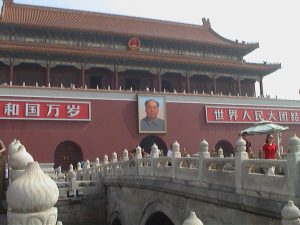
It was also a good thing that we got to go again because Robert discovered that morning that he had forgotten to pack the extra DV video tapes and needed to buy more. When we had been there earlier, he had noticed a particular sales cart on the inner courtyard offering camera supplies like this at a good price. He also bought a hat in Tiananmen Square for $2.
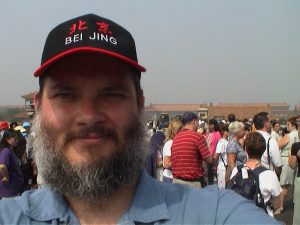
Off to the airport and our trip to Nanchang. Remember how in the U.S. the planes are not allowed to move away from the gate unless and until everyone is sitting down, with seatbelts fastened, tray tables in the full, upright…you know the drill. Well, not necessarily so in China. For some reason, we weren’t allowed on board until what seemed to be the very last minute, though our plane had long since pulled up and looked ready. When they did finally let us board, the crew was in a terrible rush. The door was closed and the engines were started hastily. Perhaps a third of the passengers were still standing in the aisles, stowing their carry-on baggage, when the plane backed away from the gate. One or two were still on their feet even when we reached the runway. The captain put the engines to full throttle for takeoff as one of the flight attendants scurried up the aisle. There was no time for her to make it to her post–she dropped into an empty aisle seat just as the plane’s nose lifted into the air. What price on-time departure goals….?!
The flight was relatively uneventful otherwise and we soon landed in Nanchang, nicknamed “the blast furnace of China” both for its exquisite porcelain and for its incredibly hot, humid weather. The bus sent to take us to the hotel couldn’t carry all our luggage, so an additional truck was put to work just for that purpose. This truck seemed pretty typical of vehicles in China: functional, but totally without frills.
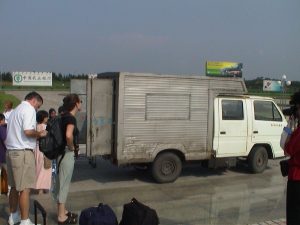
And regarding “frills” in this very pragmatic country: We learned in Beijing that a bus ride on a vehicle with air conditioning costs more than a ride on one without. (Makes sense, right?–except when you assume, as we do in the States, that air conditioning is a God-given right.) Thank heaven that our bus from the airport was frilly! Step outside in this weather and you breathe hard at once.
The trip from the airport took us through a deeply green, velvet, irregular landscape of rice paddies and terraced vegetable patches, dotted by the occasional barefoot farmer and water buffalo squeegeeing the mud from individual plots. Opportunistic egrets and herons followed in their wake, apparently capitalizing on whatever frogs or fishes were being exposed. Jianxi Province looks like lush farm country, but our guide admitted that it is very, very poor–in part because rice prices are so low–and has far to go to catch up with the rest of the nation.
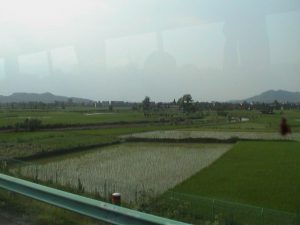
Nanchang is the capital of Jiangxi and is located in the north of the province just southwest of the massive freshwater lake Poyang Hu.
The city is best known for the events that became a turning point in the history of the People’s Republic of China. On August 1, 1927, the Nanchang Uprising occurred. 30,000 troops led by Zhou Enlai and Zhu De mutinied against Chiang Kai Shek’s Nationalist KMT. The Communists managed to hold Nanchang for 3 days before the Nationalists regained power. Though the uprising failed, it was a critical historical event as it led to the consolidation of the Communists’ power base.
After leaving Nanchang, the soldiers regrouped in the mountains in nearby Jinggangshan, joined with Mao Zedong’s men, and started the Long March.
August 1 is now marked as the anniversary of the founding of the Red Army, the People’s Liberation Army or PLA. The August 1 Uprising Museum in Nanchang commemorates these events, and there are other historical sites in the city devoted to the city’s revolutionary past.
Today, Nanchang is an industrialized city and its urban landscape has been heavily influenced by the revolutionary years and Soviet-style industrialism. August 1 Square is now one of the fixtures pointed out to all tourists. Many visitors also explore the sights in Nanchang en route to the Jinggangshan mountains and the city of Jingdezhen, which is famous for its porcelain.
We reached the The Lake View Hotel at about 4:45. Very nice, modern, with a 21-story atrium. Looked like another comfortable berth.
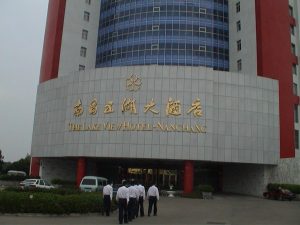
But the children were expected as early as 5:00! No time to lose! We flew up to our room and prepared ourselves for the moment we had spent the last 20 months bringing about: We were about to meet Elle.
Tune in tomorrow. Same Bat Time, same Bat Channel to find out what happened next.
Regards,
Robert & Susannah /http://eleanorjean.com